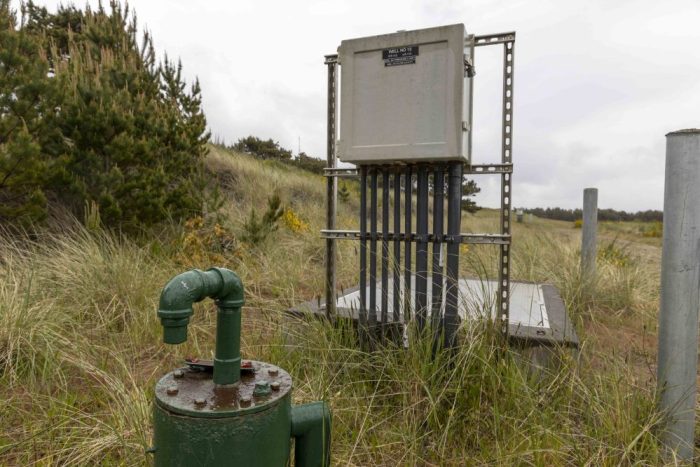Hood to smoke
Published 8:00 pm Wednesday, August 22, 2018

- Dennis Thomas works on the temporary bridge across U.S. Highway 101 for runners participating in Hood to Coast in Seaside.
SEASIDE — It looks like the smoke may clear just in time for the Hood to Coast Relay this weekend.
“We know a lot can change between now and Friday,” Dan Floyd, the relay’s chief operating officer, said. “It’s been a conversation.”
With air quality advisories in effect across much of Oregon this week, organizers of the annual race are waiting and watching conditions before issuing official guidance to the more than 19,000 participants registered to run from Mount Hood to Seaside on Friday and Saturday.
Active fires in Oregon, along with wind patterns pushing smoke south from blazes in British Columbia, have made this summer one of the smokiest yet — impacting residents and visitors, and wrinkling plans for outdoor events.
While Hood to Coast always has to anticipate and prepare for weather-related challenges, the relay has yet to face wildfire smoke as one of them.
“Four years ago we thought we might, but the issue that year turned out to be hurricane-like conditions in Seaside,” Floyd said.
If air quality remains unhealthy, organizers will defer to the judgment of the state Department of Environmental Quality, the Oregon Health Authority and the American Lung Association on coordinating an advisory that would let runners know the risks that come with breathing smoke “so participants can make an educated decision,” Floyd said.
Canceling the event would be unlikely, but possible depending on the severity of the smoke and the advice from the state, Floyd said. Organizers will work with runners with more severe health concerns on a case-by-case basis about a refund.
“Safety is always first,” Floyd said.
Kirsten Aird, the chronic disease programs manager at the Oregon Health Authority, said the most important thing a runner can do is check the Air Quality Index. If the area is marked unhealthy or higher, she recommends limiting outdoor activity altogether.
People making the decision to run should consider mitigating tactics like recirculating air in their vehicle, keeping doors closed, or carrying a rescue inhaler for those with asthma. “Listening to your body” is also recommended. Common side effects associated with smoke inhalation include watery eyes, shortness of breath and headaches.
But most importantly, Aird emphasized that runners should not rely on surgical masks or bandanas to filter out bad air. “We do feel really strongly about exposure,” she said.
While the smoke has been noticeable around Clatsop County, it has not had any apparent influence on visitor volume, according to local visitor centers.
“It’s not terribly bad here. We’re still seeing our parking lots fill up,” Cannon Beach Chamber of Commerce Director Jim Paino said.
But people are curious, Seaside Chamber of Commerce Director Brian Owen said, with calls coming in daily from people looking for a refuge from the smoke.
“We’ve had a lot of tourists leave the metro area and come over here because we’re not as inundated, even though we still have some,” Owen said. “I think a lot of people think they are at the coast so they expect to not be experiencing any of that.”
While the effects of smoke on coastal tourism have yet to be seen, other regions of the state are starting to feel the impact, said Linea Gagliano, communications director for Travel Oregon. In southern Oregon, the Oregon Shakespeare Festival has had to cancel a record 22 shows due to wildfire smoke. At about $60,000 per show, the festival is already feeling about $1 million in losses.
Travel Oregon is trying to educate communities about different grant opportunities offered to help carry them through rough financial times. The marketing organization is also doubling down on promoting tourism in the offseason, as well as convincing Oregonians to take more in-state vacations to help offset losses incurred this summer.
“We’re trying to remain as nimble as possible, sharing information about who isn’t and is affected (by the smoke),” Gagliano said. “Their trip may not be impacted, so we are trying to raise awareness so visitors can make informed vacation decisions.”
But concerns about the long-term impacts of more frequent and intense fire seasons remain.
“This is a Western problem. We need to come together as the West and ask: How do we work on this together?” Gagliano said. “Outdoor recreation is huge out here, and we all need to raise awareness. Fires don’t care about borders, and we know smoke for sure doesn’t.”
This weekend, the forecasts for cooler temperatures and rain appear to be in Hood to Coast’s favor. But with wildfires becoming more prevalent and intense throughout the Pacific Northwest, outdoor events like the relay may have to be ready to adjust.
“Every year there’s something that’s a concern,” Floyd said. “Every year we prepare to handle it.”





